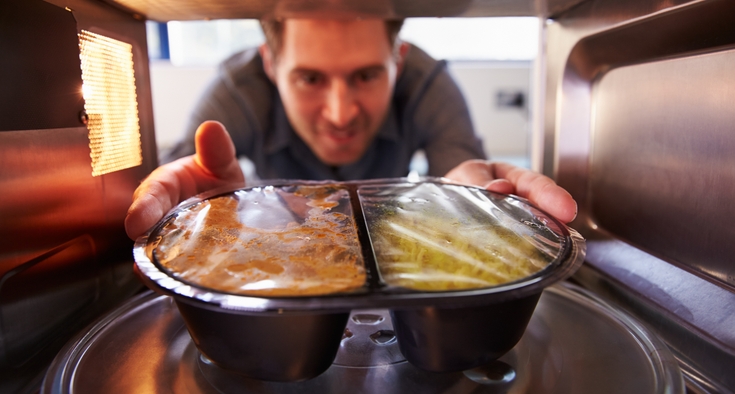Cottage cheese is one of those classic love-hate foods. And though its chunky appearance and texture is a turnoff for some of us, there’s no denying the nutritional benefits of this low-carb, protein-packed snack.
Curds are also loaded with calcium, which is good for maintaining overall bone health and blood-sugar levels. Cottage cheese is a much healthier alternative to other cheeses, but pay attention to fat and sodium levels as you shop because some brands are better than others (see below).
“Cottage cheese is a great addition to your diet, especially because there are so many reduced-sodium options,” said registered dietitian Candace Campbell of CoreLife Novant Health - Village Point. “Pairing it with fruit will add some extra fiber and make it a much more balanced, heart-healthy option.”
Looking for expert advice about healthy eating?
CoreLife clinics offer weight management services, nutrition counseling and comprehensive health assessments, which include cholesterol and thyroid checks. Even if don’t live in a region served by CoreLife, Novant Health weight-loss programs and clinics can help you find the services you need.
Here, Campbell addresses the good and bad about cottage cheese. Also below, check out some healthy and tasty ways to incorporate cottage cheese into homemade salad dressing, dip and even ice cream.
Should I be incorporating cottage cheese into my daily diet?
I personally add cottage cheese to a lot of things, like my scrambled eggs in the morning. It’s packed with protein, and at CoreLife we work to increase people’s protein consumption to help them sustain their weight. The only qualms most registered dietitians have is sodium content, which can be high in cottage cheese. That’s something to watch, especially for people with certain heart conditions or high blood pressure. One cup contains about a quarter of the recommended daily sodium intake.
What’s the best way to shop for cottage cheese options?
Brands like Breakstone’s offer a reduced-sodium option. Another is Friendship Dairies, which is especially good for patients with kidney disease; it has only 45 milligrams of sodium in half a cup, versus 400 milligrams in a single serving of Daisy Brand. I also recommend going with a reduced-fat option, because the calories add up.
Cottage cheese is also a great option if you’re plant-based. Plant-based doesn’t necessarily mean dairy-free, and there are also lactose-free options which can be helpful as we age.
With cottage cheese, how important is the portion?
Half a cup is the recommended portion size. Plenty of my patients like a full cup of cottage cheese with blueberries for their snack. But this depends on the individual’s overall health, and every case is different. For example, someone with symptoms of kidney disease should stick to half a cup.
What's a good way to introduce cottage cheese to our kids?
It’s not the most appealing-looking food. Your child is more likely to try something unfamiliar if it’s paired with something they’re already a fan of. That might mean using cottage cheese as a dip for fruit, raw vegetables or even a less-healthy snack option like potato chips. You can also blend cottage cheese to remove the chunks and make a creamier and more nutritional spaghetti sauce.
Butter pecan cottage cheese ice cream
Ingredients:
- 3 tablespoons butter
- 1 tablespoon sugar
- 1 cup pecans, coarsely chopped
- 16 ounces full-fat cottage cheese
- 1/4 cup honey
- 1 teaspoon vanilla
Preparation:
In a small skillet or saucepan, melt the butter over medium-low heat and add the sugar, stirring until well mixed. Add the pecans and stir to coat, then cook about 5 minutes, stirring frequently and watching to make sure the nuts don’t burn.
Remove from heat and set aside until cool.
Place the cottage cheese, honey and vanilla in a food processor and puree until smooth. Pour into a loaf pan and place in the freezer for 1 hour.
Remove from freezer and add the pecan mixture, stirring until it’s mixed well and smoothed back out. Return to the freezer for 3 hours longer. Let stand about 10 minutes at room temperature before scooping.
Yield: 4 (1/2-cup) servings. Per serving: 447 calories; fat 32.8 g (8.9 g saturated fat, 0.5 g trans fat); 40.7 mg cholesterol; 332.9 mg sodium; 28.1 g carbohydrates; 14.3 g protein.
Cottage cheese ranch dressing
Ingredients:
- 1 1/4 cups low-fat cottage cheese
- 3/4 cup low-fat buttermilk (see note)
- 1/4 cup minced onion
- 2 cloves garlic, peeled and minced
- 1 teaspoon kosher salt
- 1/2 teaspoon freshly ground black pepper
- 1/2 teaspoon dillweed
- 1/4 cup fresh parsley, chopped
- 1/4 cup fresh basil, chopped
- 2 tablespoons chives, snipped
Preparation:
Place the cottage cheese and buttermilk in a food processor and process until smooth. (If you want to use it as a dip, reduce the buttermilk to 1/3 cup for a thicker consistency.)
Add the remaining ingredients and process until well-mixed. Store in the refrigerator up to 1 week.
Yield: About 1 1/2 cups. Per 2-tablespoon serving: 28.5 calories; 0.7 g fat (0.4 g saturated fat); 2.7 mg cholesterol; 190 mg sodium; 2.5 g carbohydrates (1.8 g sugar); 3.4 g protein.
Lemon cottage cheese pancakes with blueberry compote
Ingredients:
- 1 cup reduced-fat cottage cheese
- 2 eggs
- 1/2 teaspoon vanilla
- 1/2 tablespoon baking powder
- 1/2 cup all-purpose flour
- Grated zest of 1 lemon
- 1 tablespoon lemon juice
- Olive oil for frying
Blueberry compote:
- 1 cup fresh blueberries
- 1 tablespoon pure maple syrup
Preparation:
Preheat oven to 200 degrees.
Place the cottage cheese, eggs, vanilla, baking powder and flour in a large bowl. Mix together until combined, but still a little lumpy. Mix in the lemon zest and lemon juice.
Heat a nonstick skillet over medium heat and add about 1 teaspoon olive oil. Pour in about 1/4 to 1/2 cup batter. Cook for 5 minutes or until bubbly on top. Flip over and brown the other side about 5 minutes.
Place pancake in the oven on a rack to keep warm. Continue cooking with remaining batter.
While the pancakes are cooking, place the blueberries and syrup in a small saucepan over medium heat. Cook, stirring for 8 to 10 minutes, until the berries release their juice, forming a thick sauce.
Serve the pancakes topped with the blueberry sauce.
Yield: 2 servings. Per serving: 357 calories; 8.4 g fat (3.2g saturated fat); 196 mg cholesterol; 780 mg sodium; 48 g carbohydrates (18.5 g sugar); 23 g protein.










